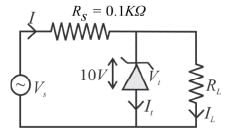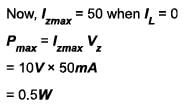Physics Exam > Physics Questions > A 10V zener diode working as a voltage regula...
Start Learning for Free
A 10V zener diode working as a voltage regulator operates from a source that varies from 5 V to 15V, the series resistance is 0.1kΩ and the load draws a current that varies from 0 to 20mA. The power dissipation in the zener diode under worst case (in Watts) is?
Correct answer is '0.5'. Can you explain this answer?
| FREE This question is part of | Download PDF Attempt this Test |
Verified Answer
A 10V zener diode working as a voltage regulator operates from a sourc...

For maximum power dissipation, current through zener diode should be maximum which is maximum when total current in the circuit is maximum i.e. Vs = 15V.


The correct answer is: 0.5
Most Upvoted Answer
A 10V zener diode working as a voltage regulator operates from a sourc...

For maximum power dissipation, current through zener diode should be maximum which is maximum when total current in the circuit is maximum i.e. Vs = 15V.


The correct answer is: 0.5
Free Test
FREE
| Start Free Test |
Community Answer
A 10V zener diode working as a voltage regulator operates from a sourc...
To calculate the minimum and maximum current flowing through the zener diode, we need to consider the worst-case scenarios.
Minimum voltage across the zener diode:
V_min = Source voltage - Zener voltage
V_min = 5V - 10V = -5V (negative voltage is not possible)
Therefore, the minimum voltage across the zener diode is 0V.
Maximum voltage across the zener diode:
V_max = Source voltage - Zener voltage
V_max = 15V - 10V = 5V
To calculate the maximum current:
I_max = V_max / R_s
I_max = 5V / 0.1kΩ = 50mA
Therefore, the zener diode will have a minimum current of 0A and a maximum current of 50mA flowing through it.
Minimum voltage across the zener diode:
V_min = Source voltage - Zener voltage
V_min = 5V - 10V = -5V (negative voltage is not possible)
Therefore, the minimum voltage across the zener diode is 0V.
Maximum voltage across the zener diode:
V_max = Source voltage - Zener voltage
V_max = 15V - 10V = 5V
To calculate the maximum current:
I_max = V_max / R_s
I_max = 5V / 0.1kΩ = 50mA
Therefore, the zener diode will have a minimum current of 0A and a maximum current of 50mA flowing through it.

|
Explore Courses for Physics exam
|

|
Similar Physics Doubts
A 10V zener diode working as a voltage regulator operates from a source that varies from 5 V to 15V, the series resistance is 0.1kΩ and the load draws a current that varies from 0 to 20mA. The power dissipation in the zener diode under worst case (in Watts) is?Correct answer is '0.5'. Can you explain this answer?
Question Description
A 10V zener diode working as a voltage regulator operates from a source that varies from 5 V to 15V, the series resistance is 0.1kΩ and the load draws a current that varies from 0 to 20mA. The power dissipation in the zener diode under worst case (in Watts) is?Correct answer is '0.5'. Can you explain this answer? for Physics 2024 is part of Physics preparation. The Question and answers have been prepared according to the Physics exam syllabus. Information about A 10V zener diode working as a voltage regulator operates from a source that varies from 5 V to 15V, the series resistance is 0.1kΩ and the load draws a current that varies from 0 to 20mA. The power dissipation in the zener diode under worst case (in Watts) is?Correct answer is '0.5'. Can you explain this answer? covers all topics & solutions for Physics 2024 Exam. Find important definitions, questions, meanings, examples, exercises and tests below for A 10V zener diode working as a voltage regulator operates from a source that varies from 5 V to 15V, the series resistance is 0.1kΩ and the load draws a current that varies from 0 to 20mA. The power dissipation in the zener diode under worst case (in Watts) is?Correct answer is '0.5'. Can you explain this answer?.
A 10V zener diode working as a voltage regulator operates from a source that varies from 5 V to 15V, the series resistance is 0.1kΩ and the load draws a current that varies from 0 to 20mA. The power dissipation in the zener diode under worst case (in Watts) is?Correct answer is '0.5'. Can you explain this answer? for Physics 2024 is part of Physics preparation. The Question and answers have been prepared according to the Physics exam syllabus. Information about A 10V zener diode working as a voltage regulator operates from a source that varies from 5 V to 15V, the series resistance is 0.1kΩ and the load draws a current that varies from 0 to 20mA. The power dissipation in the zener diode under worst case (in Watts) is?Correct answer is '0.5'. Can you explain this answer? covers all topics & solutions for Physics 2024 Exam. Find important definitions, questions, meanings, examples, exercises and tests below for A 10V zener diode working as a voltage regulator operates from a source that varies from 5 V to 15V, the series resistance is 0.1kΩ and the load draws a current that varies from 0 to 20mA. The power dissipation in the zener diode under worst case (in Watts) is?Correct answer is '0.5'. Can you explain this answer?.
Solutions for A 10V zener diode working as a voltage regulator operates from a source that varies from 5 V to 15V, the series resistance is 0.1kΩ and the load draws a current that varies from 0 to 20mA. The power dissipation in the zener diode under worst case (in Watts) is?Correct answer is '0.5'. Can you explain this answer? in English & in Hindi are available as part of our courses for Physics.
Download more important topics, notes, lectures and mock test series for Physics Exam by signing up for free.
Here you can find the meaning of A 10V zener diode working as a voltage regulator operates from a source that varies from 5 V to 15V, the series resistance is 0.1kΩ and the load draws a current that varies from 0 to 20mA. The power dissipation in the zener diode under worst case (in Watts) is?Correct answer is '0.5'. Can you explain this answer? defined & explained in the simplest way possible. Besides giving the explanation of
A 10V zener diode working as a voltage regulator operates from a source that varies from 5 V to 15V, the series resistance is 0.1kΩ and the load draws a current that varies from 0 to 20mA. The power dissipation in the zener diode under worst case (in Watts) is?Correct answer is '0.5'. Can you explain this answer?, a detailed solution for A 10V zener diode working as a voltage regulator operates from a source that varies from 5 V to 15V, the series resistance is 0.1kΩ and the load draws a current that varies from 0 to 20mA. The power dissipation in the zener diode under worst case (in Watts) is?Correct answer is '0.5'. Can you explain this answer? has been provided alongside types of A 10V zener diode working as a voltage regulator operates from a source that varies from 5 V to 15V, the series resistance is 0.1kΩ and the load draws a current that varies from 0 to 20mA. The power dissipation in the zener diode under worst case (in Watts) is?Correct answer is '0.5'. Can you explain this answer? theory, EduRev gives you an
ample number of questions to practice A 10V zener diode working as a voltage regulator operates from a source that varies from 5 V to 15V, the series resistance is 0.1kΩ and the load draws a current that varies from 0 to 20mA. The power dissipation in the zener diode under worst case (in Watts) is?Correct answer is '0.5'. Can you explain this answer? tests, examples and also practice Physics tests.

|
Explore Courses for Physics exam
|

|
Suggested Free Tests
Signup for Free!
Signup to see your scores go up within 7 days! Learn & Practice with 1000+ FREE Notes, Videos & Tests.


















